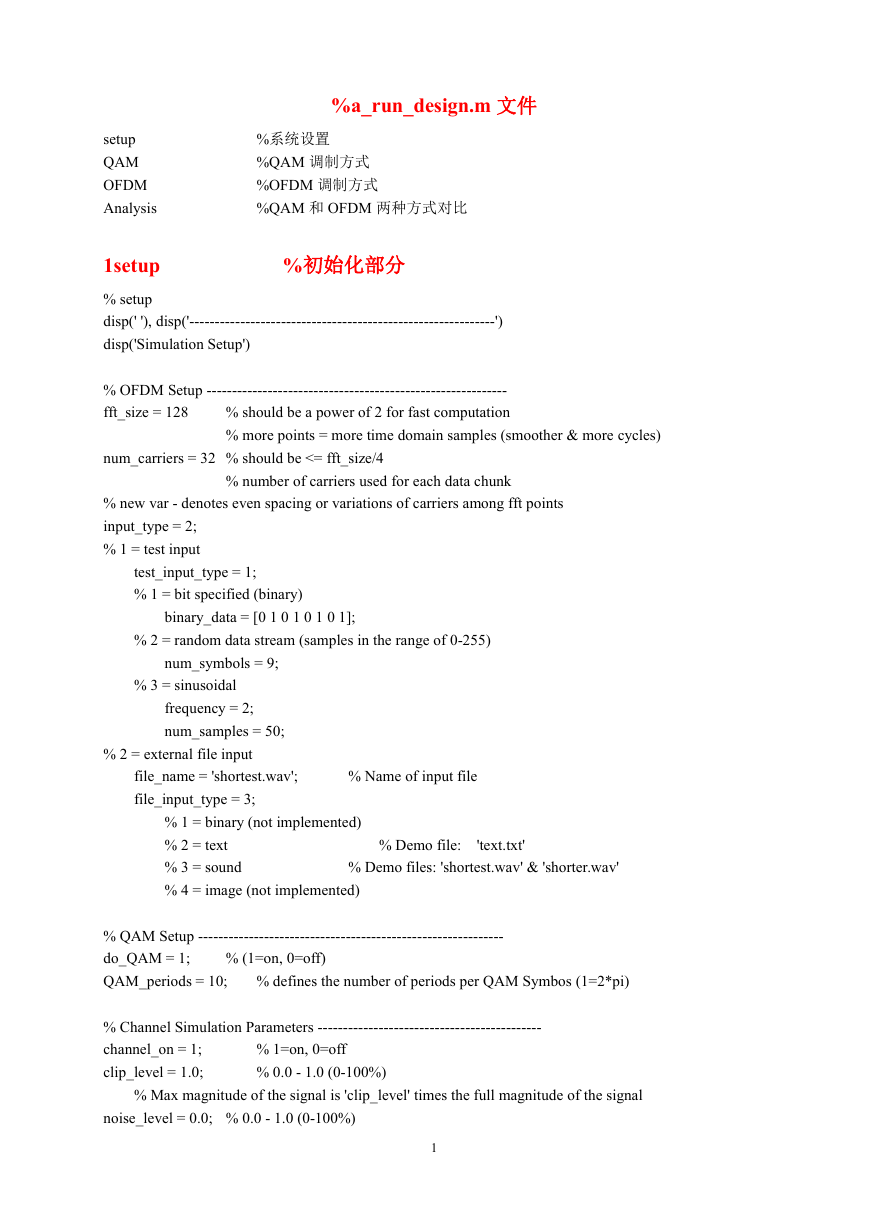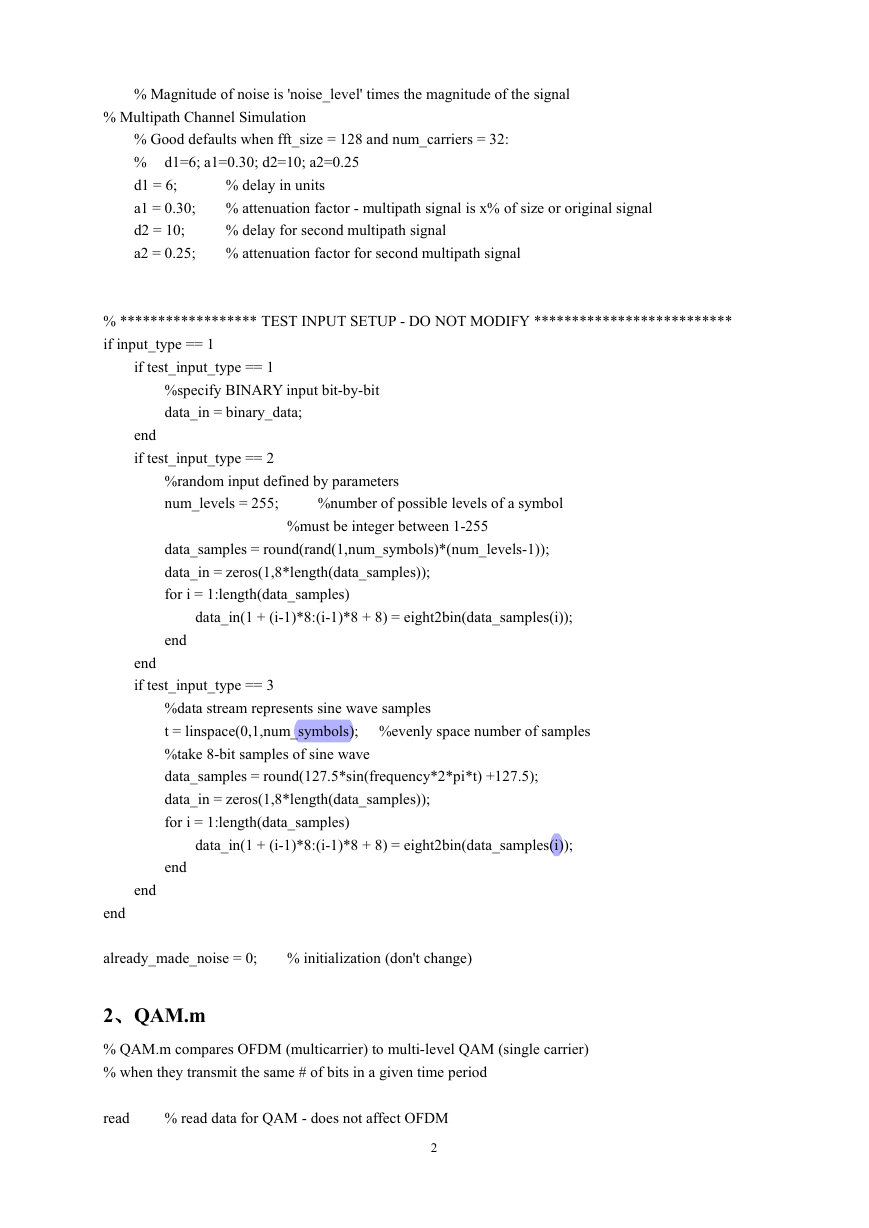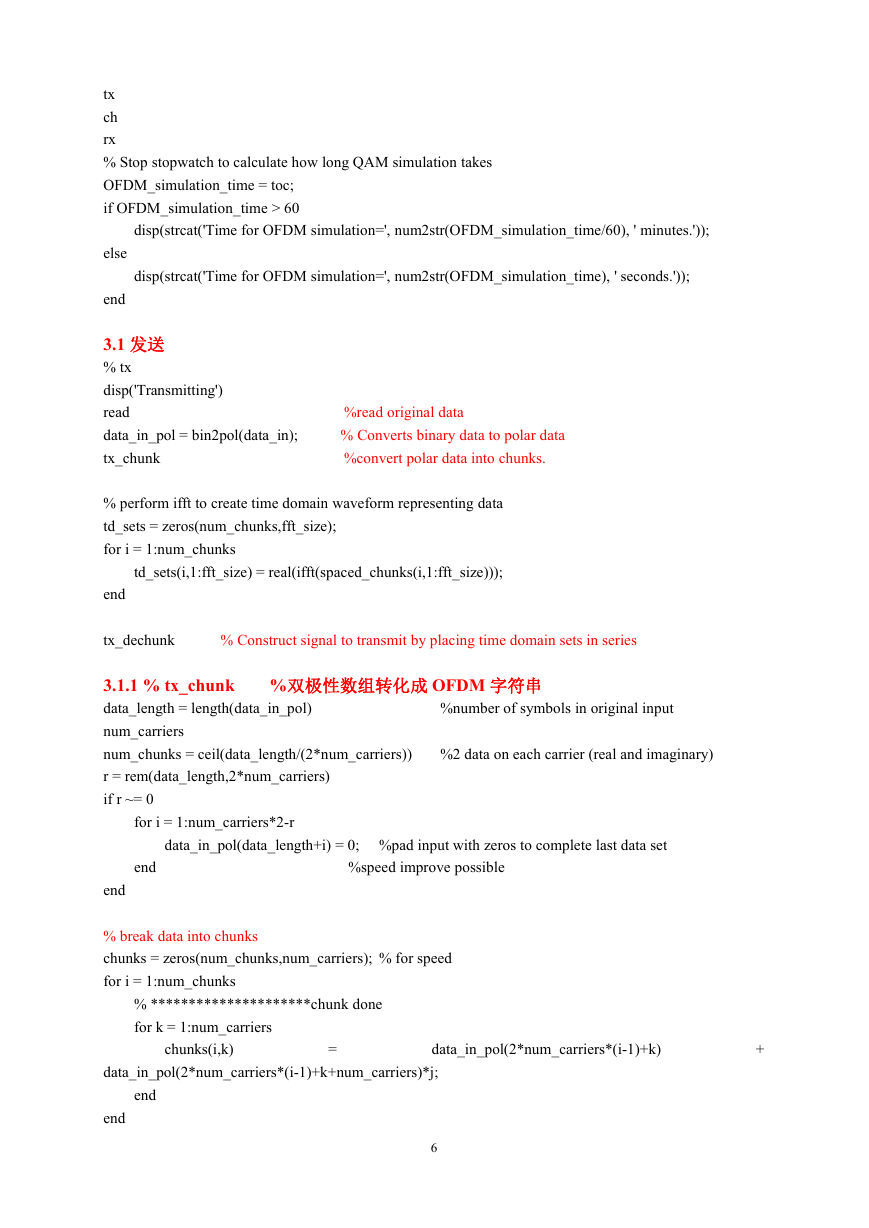%a_run_design.m 文件
setup
QAM
OFDM
Analysis
%系统设置
%QAM 调制方式
%OFDM 调制方式
%QAM 和 OFDM 两种方式对比
%初始化部分
1setup
% setup
disp(' '), disp('------------------------------------------------------------')
disp('Simulation Setup')
% OFDM Setup -----------------------------------------------------------
fft_size = 128
% should be a power of 2 for fast computation
% more points = more time domain samples (smoother & more cycles)
num_carriers = 32 % should be <= fft_size/4
% number of carriers used for each data chunk
% new var - denotes even spacing or variations of carriers among fft points
input_type = 2;
% 1 = test input
test_input_type = 1;
% 1 = bit specified (binary)
binary_data = [0 1 0 1 0 1 0 1];
% 2 = random data stream (samples in the range of 0-255)
num_symbols = 9;
% 3 = sinusoidal
frequency = 2;
num_samples = 50;
% 2 = external file input
file_name = 'shortest.wav';
file_input_type = 3;
% Name of input file
% 1 = binary (not implemented)
% 2 = text
% 3 = sound
% 4 = image (not implemented)
% Demo file:
'text.txt'
% Demo files: 'shortest.wav' & 'shorter.wav'
% QAM Setup ------------------------------------------------------------
do_QAM = 1;
QAM_periods = 10;
% (1=on, 0=off)
% defines the number of periods per QAM Symbos (1=2*pi)
% Channel Simulation Parameters --------------------------------------------
channel_on = 1;
clip_level = 1.0;
% 1=on, 0=off
% 0.0 - 1.0 (0-100%)
% Max magnitude of the signal is 'clip_level' times the full magnitude of the signal
noise_level = 0.0; % 0.0 - 1.0 (0-100%)
1
�
% Magnitude of noise is 'noise_level' times the magnitude of the signal
% Multipath Channel Simulation
% Good defaults when fft_size = 128 and num_carriers = 32:
% d1=6; a1=0.30; d2=10; a2=0.25
d1 = 6;
a1 = 0.30;
d2 = 10;
a2 = 0.25;
% delay in units
% attenuation factor - multipath signal is x% of size or original signal
% delay for second multipath signal
% attenuation factor for second multipath signal
% ****************** TEST INPUT SETUP - DO NOT MODIFY **************************
if input_type == 1
if test_input_type == 1
%specify BINARY input bit-by-bit
data_in = binary_data;
end
if test_input_type == 2
%random input defined by parameters
num_levels = 255;
%number of possible levels of a symbol
%must be integer between 1-255
data_samples = round(rand(1,num_symbols)*(num_levels-1));
data_in = zeros(1,8*length(data_samples));
for i = 1:length(data_samples)
data_in(1 + (i-1)*8:(i-1)*8 + 8) = eight2bin(data_samples(i));
end
end
if test_input_type == 3
%data stream represents sine wave samples
t = linspace(0,1,num_symbols); %evenly space number of samples
%take 8-bit samples of sine wave
data_samples = round(127.5*sin(frequency*2*pi*t) +127.5);
data_in = zeros(1,8*length(data_samples));
for i = 1:length(data_samples)
data_in(1 + (i-1)*8:(i-1)*8 + 8) = eight2bin(data_samples(i));
end
end
end
already_made_noise = 0;
% initialization (don't change)
2、QAM.m
% QAM.m compares OFDM (multicarrier) to multi-level QAM (single carrier)
% when they transmit the same # of bits in a given time period
read
% read data for QAM - does not affect OFDM
2
�
data_in_pol = bin2pol(data_in);
% Converts binary data to polar data
% check to see if num_carriers is a power of 2
is_pow_2 = num_carriers;
temp_do_QAM = 0;
if is_pow_2 ~= 2
while temp_do_QAM == 0
temp_do_QAM = rem(is_pow_2,2);
is_pow_2 = is_pow_2/2;
if is_pow_2 == 2
temp_do_QAM = -99;
% it is a power of 2 -> can do QAM
end
end
else
temp_do_QAM = -99; % 2 is a power of 2
end
if temp_do_QAM ~= -99
do_QAM = 0; % don't do it if it's not possible
disp(' '),disp('ERROR: Cannot run QAM because num_carriers is not valid.')
disp('
Please see "setup.m" for details.')
end
if do_QAM == 1
tic % Start stopwatch to calculate how long QAM simulation takes
disp(' '), disp('------------------------------------------------------------')
disp('QAM simulation'), disp('Transmitting')
% Pad with zeros so data can be divided evenly
data_length = length(data_in_pol);
r = rem(data_length,num_carriers);
if r ~= 0
for i = 1:num_carriers-r
data_in_pol(data_length+i) = 0; %pad input with zeros to complete last data set
end
%speed improve possible
end
data_length = length(data_in_pol);
%update after padding
num_OFDM_symbols = ceil(data_length / (2*num_carriers));
% num QAM symbols that represent equal amount of data to one OFDM symbol
num_QAM_symbols = num_carriers / 2;
% num samples per QAM symbol
num_symbol_samples = fft_size / num_QAM_symbols;
% convert polar data [-1, 1] to 4 level data [-3, -1, 1, 3]
3
�
data_in_4 = zeros(1,data_length/2);
for i = 1:2:data_length
data_in_4(i - (i-1)/2) = data_in_pol(i)*2 + data_in_pol(i+1);
end
% define sample points between 0 and 2*pi
ts = linspace(0, 2*pi*QAM_periods, num_symbol_samples+1);
% Generate 16-QAM data
% total length of 16-QAM transmission
tx_length = num_OFDM_symbols * num_QAM_symbols * num_symbol_samples;
QAM_tx_data = zeros(1,tx_length);
for i = 1:2:data_length/2
for k = 1:num_symbol_samples
QAM_tx_data(k+((i-1)/2)*num_symbol_samples)
=
data_in_4(i)*cos(ts(k))
+
data_in_4(i+1)*sin(ts(k));
end
end
% ch uses 'xmit' data and returns 'recv'
% Do channel simulation on QAM data
xmit = QAM_tx_data;
ch
QAM_rx_data = recv;
clear recv
clear xmit
% save QAM data after channel
% remove 'recv' so it won't interfere with OFDM
% remove 'xmit' so it won't interfere with OFDM
% Recover Binary data (Decode QAM)
disp('Receiving')
cos_temp = zeros(1,num_symbol_samples);
sin_temp = cos_temp;
xxx = zeros(1,data_length/4);
yyy = xxx;
QAM_data_out_4 = zeros(1,data_length/2);
%
%
% Initialize to zeros for speed
%
%
for i = 1:2:data_length/2 % "cheating"
for k = 1:num_symbol_samples
% multiply by carriers to produce high frequency term and original data
cos_temp(k) = QAM_rx_data(k+((i-1)/2)*num_symbol_samples) * cos(ts(k));
sin_temp(k) = QAM_rx_data(k+((i-1)/2)*num_symbol_samples) * sin(ts(k));
end
% LPF and decide - we will do very simple LPF by averaging
xxx(1+(i-1)/2) = mean(cos_temp);
yyy(1+(i-1)/2) = mean(sin_temp);
% Reconstruct data in serial form
QAM_data_out_4(i) = xxx(1+(i-1)/2);
QAM_data_out_4(i+1) = yyy(1+(i-1)/2);
end
4
�
% Make decision between [-3, -1, 1, 3]
for i = 1:data_length/2
if QAM_data_out_4(i) >= 1, QAM_data_out_4(i) = 3;
elseif QAM_data_out_4(i) >= 0, QAM_data_out_4(i) = 1;
elseif QAM_data_out_4(i) >= -1, QAM_data_out_4(i) = -1;
else QAM_data_out_4(i) = -3;
end
end
% Convert 4 level data [-3, -1, 1, 3] back to polar data [-1, 1]
QAM_data_out_pol = zeros(1,data_length); % "cheating"
for i = 1:2:data_length
switch QAM_data_out_4(1 + (i-1)/2)
case -3
QAM_data_out_pol(i) = -1;
QAM_data_out_pol(i+1) = -1;
case -1
QAM_data_out_pol(i) = -1;
QAM_data_out_pol(i+1) = 1;
case 1
QAM_data_out_pol(i) = 1;
QAM_data_out_pol(i+1) = -1;
case 3
QAM_data_out_pol(i) = 1;
QAM_data_out_pol(i+1) = 1;
otherwise
disp('Error detected in switch statment - This should not be happening.');
end
end
QAM_data_out = pol2bin(QAM_data_out_pol); % convert back to binary
% Stop stopwatch to calculate how long QAM simulation takes
QAM_simulation_time = toc;
if QAM_simulation_time > 60
disp(strcat('Time for QAM simulation=', num2str(QAM_simulation_time/60), ' minutes.'));
disp(strcat('Time for QAM simulation=', num2str(QAM_simulation_time), ' seconds.'));
else
end
end
3 % Run OFDM simulation
tic % Start stopwatch to calculate how long QAM simulation takes
disp(' '),disp('------------------------------------------------------------')
disp('OFDM Simulation')
5
�
tx
ch
rx
% Stop stopwatch to calculate how long QAM simulation takes
OFDM_simulation_time = toc;
if OFDM_simulation_time > 60
disp(strcat('Time for OFDM simulation=', num2str(OFDM_simulation_time/60), ' minutes.'));
disp(strcat('Time for OFDM simulation=', num2str(OFDM_simulation_time), ' seconds.'));
else
end
3.1 发送
% tx
disp('Transmitting')
read
data_in_pol = bin2pol(data_in);
tx_chunk
%read original data
% Converts binary data to polar data
%convert polar data into chunks.
% perform ifft to create time domain waveform representing data
td_sets = zeros(num_chunks,fft_size);
for i = 1:num_chunks
td_sets(i,1:fft_size) = real(ifft(spaced_chunks(i,1:fft_size)));
end
tx_dechunk
% Construct signal to transmit by placing time domain sets in series
3.1.1 % tx_chunk %双极性数组转化成 OFDM 字符串
data_length = length(data_in_pol)
num_carriers
num_chunks = ceil(data_length/(2*num_carriers))
r = rem(data_length,2*num_carriers)
if r ~= 0
%number of symbols in original input
%2 data on each carrier (real and imaginary)
for i = 1:num_carriers*2-r
data_in_pol(data_length+i) = 0; %pad input with zeros to complete last data set
%speed improve possible
end
end
% break data into chunks
chunks = zeros(num_chunks,num_carriers); % for speed
for i = 1:num_chunks
% *********************chunk done
for k = 1:num_carriers
chunks(i,k)
=
data_in_pol(2*num_carriers*(i-1)+k)
+
data_in_pol(2*num_carriers*(i-1)+k+num_carriers)*j;
end
end
6
�
chunks
% Padding chunks with zeros so num_carriers and fft_size are compatible
% Once compatible, further spacing is simplified
num_desired_carriers = num_carriers;
num_zeros = 0;
thinking = 1;
while thinking == 1 % Continue if num_carriers and fft_size are not compatible
if rem(fft_size/2,num_desired_carriers) == 0
thinking = 0;
num_desired_carriers = num_desired_carriers + 1;
num_zeros = num_zeros + 1;
else
end
end
padded_chunks = zeros(num_chunks,num_carriers + num_zeros); % for speed
padded_chunks(1:num_chunks,num_zeros + 1:num_carriers + num_zeros) = chunks;
%compute zeros_between
zeros_between = ((fft_size/2) - (num_carriers + num_zeros))/(num_carriers + num_zeros);
spaced_chunks = zeros(num_chunks,fft_size); % for speed - extra room for folding later
%add zeros_between
i = 1;
for k = zeros_between +1:zeros_between +1:fft_size/2
spaced_chunks(1:num_chunks,k) = padded_chunks(1:num_chunks,i);
i = i+1;
end
% folding data to produce an odd function for ifft input
for i = 1:num_chunks
% Note: index = 1 is actually DC freq for ifft -> it does not get copied over y-axis
spaced_chunks(i,fft_size:-1:fft_size/2+2) = conj(spaced_chunks(i,2:fft_size/2));
end
3.1.2 tx_dechunk
% tx_dechunk
% Construct signal to transmit by placing time domain sets in series
xmit = zeros(1,num_chunks*fft_size);
for i = 1:num_chunks
for k = 1:fft_size
xmit(k + (i-1)*fft_size) = td_sets(i,k);
end
7
�
end
3.2 %ch.m
% ch
recv = xmit; % channel is applied to recv, don't modify transmitted data
if channel_on == 1
disp('Simulating Channel')
norm_factor = max(abs(recv)); % Normalize all data before applying
recv = (1/norm_factor) * recv;
ch_clipping
ch_multipath
ch_noise
recv = norm_factor * recv;
%clipp data
%
%
% channel for a fair comparison
% Restore data magnitude for proper decoding
end
3.2.1 %ch_clipping.m
% ch_clipping
for i = 1:length(recv)
if recv(i) > clip_level
recv(i) = clip_level;
end
if recv(i) < -clip_level
recv(i) = -clip_level;
end
end
3.2.2 % ch_multipath
copy1=zeros(size(recv));
for i=1+d1:length(recv)
copy1(i)=a1*recv(i-d1);
end
copy2=zeros(size(recv));
for i=1+d2:length(recv)
copy2(i)=a2*recv(i-d2);
end
recv=recv+copy1+copy2;
% 产生多经的方法
3.2.3、%ch_noise
%施加信道噪声
% ch_noise (operate on recv)
% random noise defined by noise_level amplitude
if already_made_noise == 0 % only generate once and use for both QAM and OFDM
noise = (rand(1,length(recv))-0.5)*2*noise_level;
already_made_noise = 1;
end
recv = recv + noise;
8
�
















 2023年江西萍乡中考道德与法治真题及答案.doc
2023年江西萍乡中考道德与法治真题及答案.doc 2012年重庆南川中考生物真题及答案.doc
2012年重庆南川中考生物真题及答案.doc 2013年江西师范大学地理学综合及文艺理论基础考研真题.doc
2013年江西师范大学地理学综合及文艺理论基础考研真题.doc 2020年四川甘孜小升初语文真题及答案I卷.doc
2020年四川甘孜小升初语文真题及答案I卷.doc 2020年注册岩土工程师专业基础考试真题及答案.doc
2020年注册岩土工程师专业基础考试真题及答案.doc 2023-2024学年福建省厦门市九年级上学期数学月考试题及答案.doc
2023-2024学年福建省厦门市九年级上学期数学月考试题及答案.doc 2021-2022学年辽宁省沈阳市大东区九年级上学期语文期末试题及答案.doc
2021-2022学年辽宁省沈阳市大东区九年级上学期语文期末试题及答案.doc 2022-2023学年北京东城区初三第一学期物理期末试卷及答案.doc
2022-2023学年北京东城区初三第一学期物理期末试卷及答案.doc 2018上半年江西教师资格初中地理学科知识与教学能力真题及答案.doc
2018上半年江西教师资格初中地理学科知识与教学能力真题及答案.doc 2012年河北国家公务员申论考试真题及答案-省级.doc
2012年河北国家公务员申论考试真题及答案-省级.doc 2020-2021学年江苏省扬州市江都区邵樊片九年级上学期数学第一次质量检测试题及答案.doc
2020-2021学年江苏省扬州市江都区邵樊片九年级上学期数学第一次质量检测试题及答案.doc 2022下半年黑龙江教师资格证中学综合素质真题及答案.doc
2022下半年黑龙江教师资格证中学综合素质真题及答案.doc